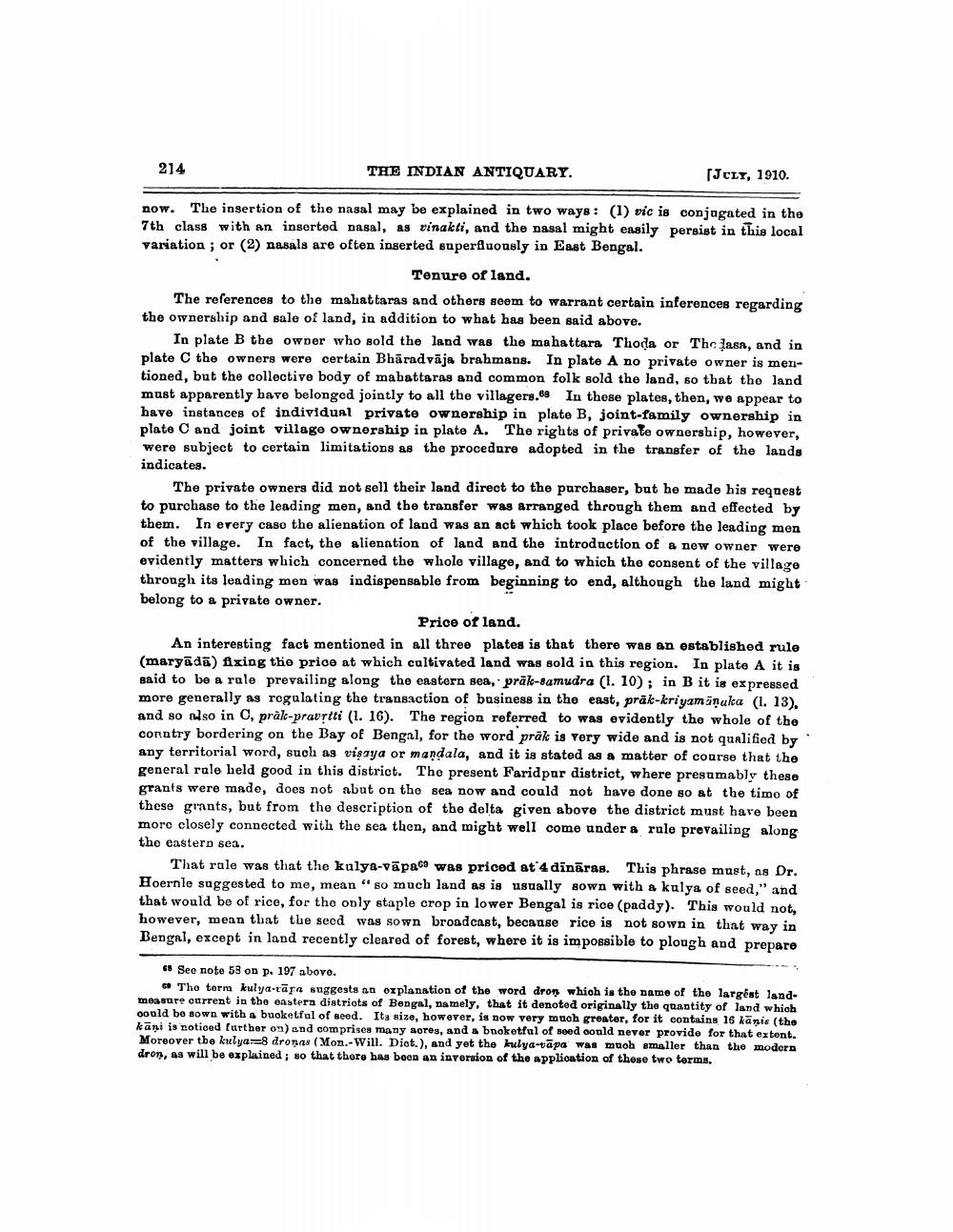________________
214
THE INDIAN ANTIQUARY.
[JCLY, 1910.
now. The insertion of the nasal may be explained in two ways: (1) vic is conjugated in the 7th class with an inserted nasal, as vinakti, and the nasal might easily persist in this local variation ; or (2) nasals are often inserted superfluously in East Bengal.
Tenure of land. The references to the mahattaras and others seem to warrant certain inferences regarding the ownership and sale of land, in addition to what has been said above.
In plate B the owner who sold the land was the mahattara Thoda or The Lasa, and in plate C the owners were certain Bharadvāja brahmans. In plate A no private owner is mentioned, but the collective body of mabattaras and common folk sold the land, so that the land must apparently bave belonged jointly to all the villagers.ee In these plates, then, we appear to have instances of individual private ownership in plate B, joint-family ownership in plate C and joint village ownership in plate A. The rights of private ownership, however, were subject to certain limitations as the procedure adopted in the transfer of the lands indicates.
The private owners did not sell their land direct to the purchaser, but he made his request to purchase to the leading men, and the transfer was arranged through them and effected by them. In erery case the alienation of land was an act which took place before the leading men of the village. In fact, the alienation of land and the introduction of a new owner were evidently matters which concerned the whole village, and to which the consent of the village through its leading men was indispensable from beginning to end, although the land might belong to a private owner.
Price of land. An interesting fact mentioned in all three plates is that there was an established rule (maryādā) fixing the price at which cultivated land was sold in this region. In plate A it is said to be a rale prevailing along the eastern sea, prāk-samudra (l. 10); in B it is expressed more generally as regulating the transaction of business in the east, prak-kriyamāņuka (1. 13). and so also in C, pral-pravrtti (1. 16). The region referred to was evidently the whole of the conntry bordering on the Bay of Bengal, for the word präk is very wide and is not qualified by any territorial word, such as visaya or mandala, and it is stated as a matter of course that the general rale held good in this district. The present Faridpur district, where presumably these grants were made, does not abut on the sea now and could not have done so at the time of these grants, but from the description of the delta given above the district must have been more closely connected with the sea then, and might well come under a rulo prevailing along the eastern sea.
That role was that the kulya-vāpaco was priced at 4 dināras. This phrase must, as Dr. Hoernle suggested to me, mean " so much land as is usually down with a kulya of seed," and that would be of rico, for the only staple crop in lower Bengal is rice (paddy). This would not, however, mean that the seed was sown broadcast, because rice is not sown in that way in Bengal, except in land recently cleared of forest, where it is impossible to plough and prepare
See note 53 on p. 197 above.
@ Tho torm kulya.tāra suggests an explanation of the word dron which is the name of the largest landmeasure ourrent in the eastern distriots of Bengal, namely, that it donotod originally the quantity of land which could be sown with a buoketful of seed. Its size, however, is now very much greater, for it contains kāni is noticed further on) and comprises many mores, and a broketful of seed could never provide for that extent. Moreover the kulyar8 dronas (Mon.-Will. Diot.), and yet the kulya-vāpa was muoh smaller than the modern dron, as will be explained; so that there has been an inversion of the application of these two torms.




